How small changes can improve our teaching
By Derek Graf
As instructors, we sometimes look for ways to create big changes in our courses, departments, and degree programs. Searching for complete overhauls to our teaching practices, we risk losing sight of the small changes we can make in our next class meeting.
James M. Lang, author of Small Teaching: Everyday Lessons from the Science of Learning, believes that fundamental pedagogical improvement is possible through incremental change (4). For example, he explains how asking students to make predictions increases their ability to understand course material and retrieve prior knowledge. He offers various strategies for incorporating prediction exercises into the classroom, such as utilizing a brief pretest on new material at the beginning of class, asking students to predict the outcome of a problem, or closing class by asking students to make predictions about material that will be covered in the next class (60). As Lang says, “predictions make us curious,” and as instructors we can encourage student curiosity if we allow them to make predictions about the course material.
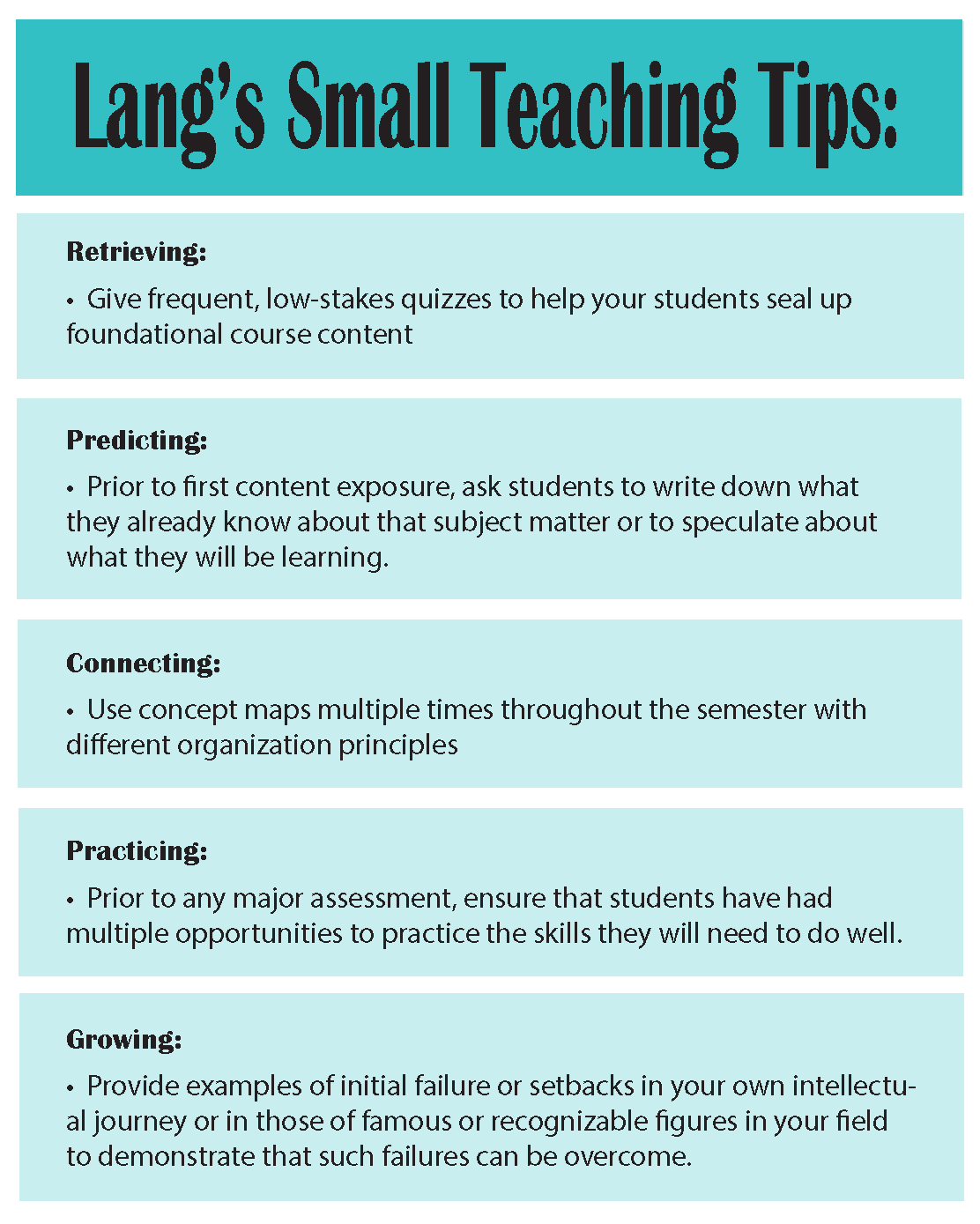
In Small Teaching, Lang shows how instructors can capitalize on minor shifts to a lesson plan to motivate students, help them connect with new content, and give them time to practice the skills required on formal essays and exams. As Lang explains in the introduction, small teaching defines a pedagogical approach “that seeks to spark positive change in higher education through small but powerful modifications to our course design and teaching practices” (5). Lang argues that big changes begin with each new class, and he provides numerous strategies for enacting those changes.
An English professor and director of the Center for Teaching Excellence at Assumption College in Worcester, Mass., Lang says that small teaching practices can be utilized by teachers from any discipline, in any course, at any point in the semester. Lang understands that many instructors, such as adjuncts and GTAs, lack the time and the resources necessary to make major curriculum shifts in their departments. Small teaching allows instructors of all levels to innovate their teaching and generate enthusiasm in the classroom in ways that are incremental, deliberate, and, most importantly of all, accessible.
Lang identifies accessibility as the key to the potential success of small teaching: “Teaching innovations that have the potential to spur broad changes must be as accessible to underpaid and overworked adjuncts as they are to tenured faculty at research universities” (5). The small teaching activities Lang offers fulfill this criteria because, “with a little creative thinking, they can translate into every conceivable type of teaching environment in higher education, from lectures in cavernous classrooms to discussions in small seminar rooms, from fully face-to-face to fully online courses and every blended shade in between” (6). Lang has either practiced or directly observed every piece of advice he offers in Small Teaching, and these activities fall into one of three categories:
- Brief (5-10 minute) classroom or online learning activities.
- One-time interventions in a course.
- Small modifications in course design or communication with your students.
Knowledge, understanding and inspiration
Over three sections, organized under the broad categories of “Knowledge,” “Understanding,” and “Inspiration,” Lang provides numerous ways to implement small teaching, even during the opening minutes of tomorrow’s class. For example, Lang shows how we can motivate students to develop an emotional response to the course material by telling great stories: “Once class has started, the simplest way to tap the emotions of your students is to use the method that every great orator, comedian, emcee, and preacher knows: begin with a story” (182). Drawing from the research of experimental psychologist Sarah Cavanagh, Lang explains how “when emotions are present, our cognitive capacities can heighten; so if we open class by capturing the attention of our students and activating their emotions with a story, we are priming them to learn whatever comes next” (182). While great stories don’t necessarily lead to great class sessions, they do allow for students to create an emotional bond with the course material.
The above example proved to be my favorite of the activities outlined in Small Teaching. As an instructor of freshman composition, I often feel as though my students enter college lacking a positive emotional relationship to writing. They associate writing with an instructor’s judgment on their intellectual capabilities.
Realizing this, I decided to open one of my classes with a personal story about a former instructor of mine who would humiliate students for their lack of quality prose. After sharing an anecdote in which I was the recipient of a particularly harsh and public critique, I admitted how his experience affected my confidence while also explaining that I did not let this moment define my identity as a writer or a student. I asked my students if they had any similar experiences with writing. Sure enough, several of them shared that their relationship with writing was dominated by the “red pen” approach of a past instructor, and some of them shared stories of procrastination gone wrong.
This conversation allowed me to explain my approach to grading and assessing student writing, increase my transparency as an instructor, and also commiserate with students about the difficulties of writing for an academic audience. My decision to begin class with a personal story altered the emotional climate of the room, and my students’ engagement with the course material benefited from that shift.
“Tell Great Stories” is just one of many activities Lang shares throughout Small Teaching. Balancing a personal tone with clear explanations of the psychological and cognitive research backing his argument, Lang ultimately collapses the binary between “small teaching” and “big changes.” Perhaps they are one and the same, each informing the other, and leading toward necessary shifts in higher education, one class at a time.
Addressing universities’ built-in barriers to success
By Doug Ward
The overarching message from a meeting of the University Innovation Alliance was as disturbing as it was clear: Research universities were built around faculty and administrators, not students, and they must tear down systemic barriers quickly and completely if they hope to help students succeed in the future.
About 75 representatives from the alliance’s member institutions gathered at Michigan State University last week to share ideas and to talk about successes, challenges and impediments to student success. The alliance comprises 11 U.S. research universities working to improve graduation rates among a wider range of students. Since its start five years ago, it has led efforts in predictive analytics, proactive advising, completion grants, and college-to-career activities. It has also created a fellows program that allows for concentrated attention on barriers to student success.

Speakers at the meeting certainly celebrated those efforts,but over and over they referred to systemic problems that can no longer be ignored.Those problems underlie less-than-stellar retention and graduation rates,especially among first-generation and underrepresented students, and amongthose who come from less-than-wealthy families. They loom large when youconsider that the future of universities depends on their ability to serve thevery students they once pushed away.
“There’s this belief system that low-income, first-generation, students of color, when they drop out, that there’s something about them. It’s not an indictment of the entire system,” said Bridget Burns, executive director of the UIA. That is, there’s an “unintended value system” that tells students that when they fail, it’s individual weakness, not a problem with the university.
Research universities were created to serve the elite, not the masses, and were meant to foster a “reproduction of privilege,” Burns said. Degrees were meant to be rare and difficult to earn. As a result, universities are filled with booby traps that stop students from moving toward a degree.
Burns didn’t elaborate on that, but it’s easy to see the ways that universities were designed around the needs of faculty members and administrators, not students. Students must jump through hoop after bureaucratic hoop to register for classes, arrange for financial aid, pay their bills, meet requirements, and even meet with an advisor. They attend classes at times most convenient for instructors and gather in classrooms that focus on the instructor. Universities also do a poor job of helping students learn how to learn in a college environment.
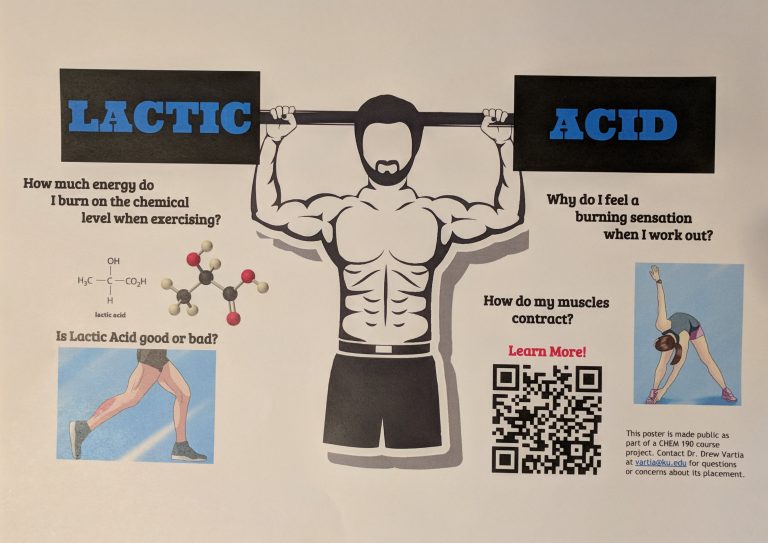
Two roads, two perceptions
Frank Dooley, senior vice provost for teaching and learning at Purdue, used two disparate images to illustrate the murky path that students must traverse. One image was of a wide open highway with smooth pavement disappearing into the horizon. The other was of a spaghetti bowl of urban interchanges, twisting and turning into a seemingly impenetrable combination of highways. Those of us involved in higher education generally see the path through universities as the open road, he said. Students see the impenetrable tangle.
That’s just the administrative side. Another barrier is the disconnect between faculty members and student success. Most faculty members do indeed care about the undergraduates in their classes, and many have transformed their courses in ways that improve class climate, retention, student interaction, critical thinking, and learning. Those efforts count for little in a university rewards system that makes research productivity the primary means of evaluation, though. As several people at the UIA meeting noted, that rewards system encourages faculty to distance themselves from students, who essentially become an impediment to tenure and promotion. It also provides no incentive to become involved in broader university efforts to help students succeed.
Grit and the myth of individualism
Claire Creighton, director of the Academic Success Center at Oregon State, provided another example of universities’ many systemic barriers as she talked of how the idea of “grit” had spread into conversations across institutions. On its own, it’s a fine concept, she said: Students need to work through adversity. Persistence pays off.
In many ways, though, grit is an extension of the American myth of the self-made man – yes, the myth is generally male-centric – the idea that a person can achieve anything through hard work and persistence, that those of no means have the same opportunity to rise to the top as those with abundant wealth. It’s a myth embedded in popular culture through stories of individual success and rugged individualism. Legislators, policy makers and universities themselves have perpetuated that myth by turning a degree into an individual commodity and an individual financial burden rather than a shared accomplishment of a democratic society.
As Creighton said, grit has become equated with student success. Those who succeed have grit and those who fail don’t. By looking at it in those terms, we create a sense of deficiency among students by blaming them for their failure rather than looking into systemic problems.
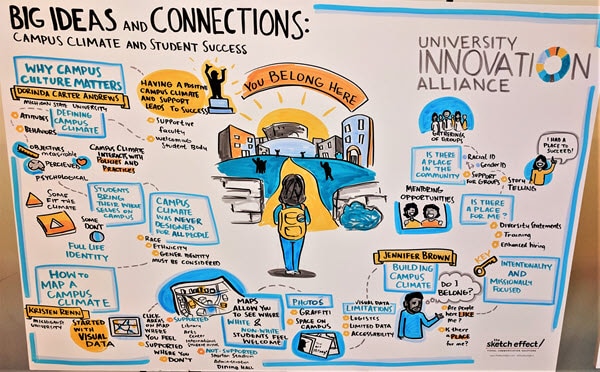
“What is it about institutions that requires students to be gritty and resilient, to overcome adversity, in order to achieve?” she asked.
I agree, but students will face repeated adversity once they leave a university. We need to help them develop the grit they will need for long-term success by helping them work through failures – and by making failure a learning experience rather than a dead end – while supporting them as they build confidence and develop skills.
Genyne Royal, assistant dean for student success initiatives at Michigan State, explained one way of doing that by paying more attention to what she called the “murky middle,” students with GPAs of 2.0 to 2.6. We generally focus most on students on academic probation, she said, and we miss those borderline students who could easily slip toward failure.
The ‘murky middle’ and the ‘secret sauce’
She equated student success to a mysterious “secret sauce” that all universities hope to find. Some years we add brown sugar, she said. Other years we add hot sauce. That is, the process must change constantly as students and their unique needs change.
That process must also help us see our campuses through the eyes of students, as Jennifer Brown, vice provost and dean for undergraduate education at the University of California, Riverside, reminded those at the UIA meeting. We too often forget what students see when they look at our programs and visit our campuses. Most certainly they consider what they will learn and where a degree will lead them. Two of the most important factors have little to do with academics, though, Brown said, and everything to do with a sense of belonging:
Are there others here like me?
Is there a place here for me?
Preparing for ‘seismic shifts’
An article this week from EAB, the educational data and consulting organization, echoed the concerns I heard at the meeting of the University Innovation Alliance. It conveyed a sense of urgency for colleges and universities to prepare for “seismic shifts” in the coming decade as demographics change and the number of high school graduates declines. Melanie Ho, executive director of EAB, recently completed a series of one-on-one discussions with university presidents. She said that administrators spoke of the urgent need for “systemic, holistic change across campus.” Institutions must focus on what makes them unique, she said, while breaking down silos and quickly pushing through changes that might usually take years to accomplish.
That need for holistic change came up in many discussions and presentations at the University Innovation Alliance gathering, as did the importance of cooperation across institutions. John Engler, interim president of Michigan State and a former Michigan governor, said global competition for talent, weak graduation rates, and growing cynicism about higher education all pointed to the need for change.
“Universities think we can’t go away,” Engler said. “Well, the world is changing. Maybe that will change.”
Enrollment figures foreshadow challenges for universities
Enrollment reports released last week hint at the challenges that colleges and universities will face in the coming decade.
Across the Kansas regents universities, enrollment fell by the equivalent of 540 full-time students, or 0.72 percent. Emporia State, Fort Hays State, Wichita State and the KU Medical Center all showed slight increases, but full-time equivalent enrollment fell at Pittsburg State (3.98 percent), Kansas State (3.09 percent), and the KU Lawrence and Edwards campuses (0.49 percent). Enrollment at community colleges fell 2.6 percent.
Those numbers reflect the regents’ shift to a metric that focuses on credit hours rather than a count of the number of students. Total undergraduate credit hours are divided by 15 and graduate credit hours by 12 to get the full-time equivalency metric. More than 60 percent of students at regents institutions enroll only part time, the regents said in a news release, and the full-time equivalency counts adjust for that. At KU’s Lawrence and Edwards campuses, 16.2 percent of students are part time. That up about 2.5 points since 2013 but still considerably lower than it was in the 1990s.
KU reported(Link unavailable) that the total number of students across its campuses grew by 63, to 28,510, although the regents’ full-time equivalency total was 24,246. KU’s growth in head count came from the medical center. On the Lawrence and Edwards campuses, the number of students declined by 76. And though the freshman class grew, diversity declined in all categories.
Without doubt, KU had several strong components in its report. The most impressive was that nearly 84 percent of 2017’s freshman class returned to the university this year. That’s an increase of 4 to 6 points from just a few years ago and the highest KU has ever recorded. That growth reflects many factors, including higher admission standards and efforts to improve teaching, advising and student outreach.
Retaining students will grow increasingly important in the coming years as U.S. birthrates decline. An analysis by Nathan Grawe of Carleton University suggests that attendance at regional four-year colleges and universities will drop by more than 15 percent by 2029. Fewer births means fewer potential students, something that could prove particularly troubling for universities in the Midwest and Northeast, where declines are expected to be the steepest.
Universities like KU rely increasingly on undergraduate tuition dollars to pay the bills, especially as states reduce funding for higher education, so a large decline in in the number of students would have significant budget consequences. Many universities have ratcheted up out-of-state recruiting and increased financial aid in hopes of attracting more students. Some have been forced to reduce out-of-state tuition rates to attract more students.
This all grows increasingly important as KU considers a budget model that would allocate departmental resources in part on the number of undergraduate credit hours. More students would mean more money. Fewer students would mean fewer departmental resources, putting ever more pressure on small departments that provide important perspectives on an ever-changing world but that are never likely to attract large numbers of students.
Long-term predictions are notoriously inaccurate, so there’s no guarantee that any single university will face an extreme drop in the number of students. You don’t have to look far, though, to see what might happen. Enrollment at Kansas State dropped by nearly 1,000 students last year, and its enrollment declined each year between 2015 and 2017. That forced a budget cut of $15 million.
To make up for declining numbers of undergraduates, many universities have developed new master’s programs, many of them online, to tap into a demand for new skills and new credentials. Between 2000 and 2015, the number of master’s degrees granted at U.S. institutions rose by more than 60 percent. They have also added online classes for undergraduates to allow more flexibility for students who often work more than 20 hours a week to pay their bills.
The vast majority of tuition dollars still come from undergraduates, and without a doubt, attracting even the same number of students will grow increasingly challenging in the coming decade. Universities can’t just play numbers games, though. Volumes of students and credit hours may pay the bills, but unless universities elevate the importance of high-quality teaching and learning, those numbers mean little. In an increasingly competitive environment, the quality of teaching matters immensely.
Neil deGrasse Tyson on professors’ communication problem
Neil deGrasse Tyson, who has made a career out of explaining science to the public, offered some strong criticism of higher education in a recent interview with The Chronicle of Higher Education. He said that a misguided rewards systems discouraged professors from reaching out beyond a small group of like-minded colleagues.
“If communicating with the public were valued in the tenure process, they’d be better at it. This is an easy problem to solve. If 20 percent of the evaluation for tenure were based on how well you communicate with the public, that’s a game changer. All of a sudden universities open up, and people learn about what you’re doing there, whether it’s bird wings or paramecia.
“But in the end, universities don’t really care. Put that in big letters.”
Doug Ward is the associate director of the Center for Teaching Excellence and an associate professor of journalism. You can follow him on Twitter @kuediting.
Why sustaining educational change requires collaboration
By Doug Ward
Howard Gobstein issued both a challenge and a warning to those of us in higher education.
Universities aren’t keeping up with the pace of societal change, he said, and the initiatives to improve education at the local, state and national levels too often work in isolation.
“We’d better start talking to one another,” said Gobstein, vice president for research policy and STEM education at the Association of Public and Land-Grant Universities.

Gobstein spoke in Lawrence last week at the annual meeting of TRESTLE, a network of faculty and academic leaders who are working with colleagues in their departments to improve teaching in science, technology, engineering and math. Pressures are building both inside and outside the university to improve education, he said, citing changing demographics, rising costs, advances in technology, and demands for accountability among the many pressure points. Universities have created initiatives to improve retention at the institutional level. Departments and disciplines, especially in STEM, have created their own initiatives. Most work independently, though.
“There are almost two different conversations occurring, I would argue,” Gobstein said. “There are those that are pushing overall and those that are pushing within STEM.”
Not only that, but national organizations have created STEM education initiatives focusing on K-12, undergraduate education, graduate education, and industry and community needs. Those initiatives often overlap, but all of them are vital for effecting change, Gobstein said.
“To transform and to make it stick, there has to be something going on across all of these levels,” he said.
Universities must also work more quickly, especially as outside organizations draw on technology to provide alternative models of education.
“There are organizations out there, there are institutions out there that are going to change the nature of education,” Gobstein said. “They are already starting to do that. They are nipping away at universities. And we ignore them at our peril.”
Gobstein made a similar argument last year at a meeting of the Bay View Alliance, a consortium of North American research universities that are working to improve teaching and learning. Demographics are changing rapidly, he said, but STEM fields are not attracting enough students from underrepresented minority groups and lower economic backgrounds.
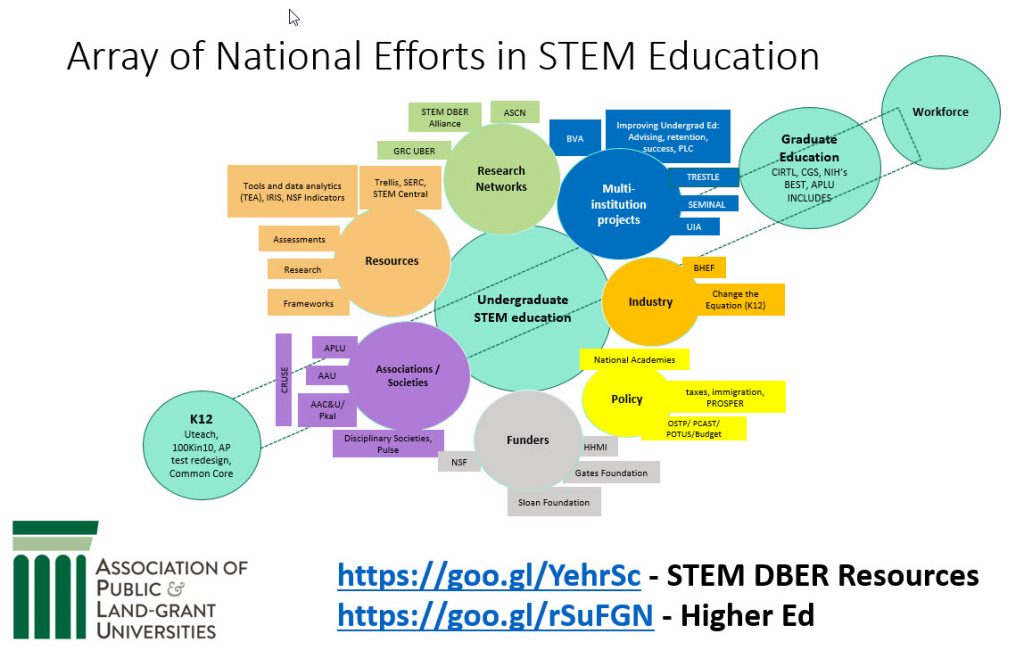
“That’s not entirely the responsibility of institutions, but they have a big role to play,” Gobstein said. “To the extent that we can transform our STEM education, our classes, our way of dealing with these students, the quicker we will be able to get a larger portion of these students into lucrative STEM fields.”
Change starts at individual institutions and in gateway courses that often hold students back, he said. Research universities must value teaching and learning more, though.
“It’s the recognition that teaching matters. It’s the recognition that counseling students matters,” Gobstein said.
Higher education is also under pressure from parents, students and governments to improve teaching and learning, to make sure students are prepared for the future, and to provide education at a price that doesn’t plunge families into debt.
“We seem to be losing ground with them as far as their confidence in our institutions to be able to provide what those students need for their future, particularly at a price that they are comfortable with,” Gobstein said.

At TRESTLE, Gobstein challenged participants with some difficult questions:
- What does teaching mean in an era of rapidly changing technology?
- How do we measure the pace of change? How do we know that we are doing better this year than in previous years?
- How do we make sure the next generation of faculty continues to bring about change but also sustains that change?
He also urged participants to seek out collaborators on their campuses who can provide support for their efforts but also connect them with national initiatives.
“What we’re really trying to do is to change how students learn, and we’re trying to make sure that all students have access and opportunity,” Gobstein said.
Despite the many challenges, Gobstein told instructors at TRESTLE that the work they were doing to improve teaching and learning was vital to the future of higher education.
“You are doing work that is some of the most important work any of us can think of doing,” Gobstein said.
“The nation needs you.”
Doug Ward is the associate director of the Center for Teaching Excellence and an associate professor of journalism. You can follow him on Twitter @kuediting.
Putting KU’s leadership in learning on display
By Doug Ward
The University of Kansas has gained international attention with its work in student-centered learning over the past five years.
Grants from the National Science Foundation, the Teagle Foundation, and the Association of American Universities have helped transform dozens of classes and helped faculty better understand students and learning. Participation in the Bay View Alliance, a North American consortium of research universities, has helped the university bolster its efforts to improve teaching and learning. And participation in organizations like the International Society for the Scholarship of Teaching and Learning, the Association of American Colleges and Universities, and the AAU has provided opportunities for KU faculty to share the rich work they have done in improving their courses.
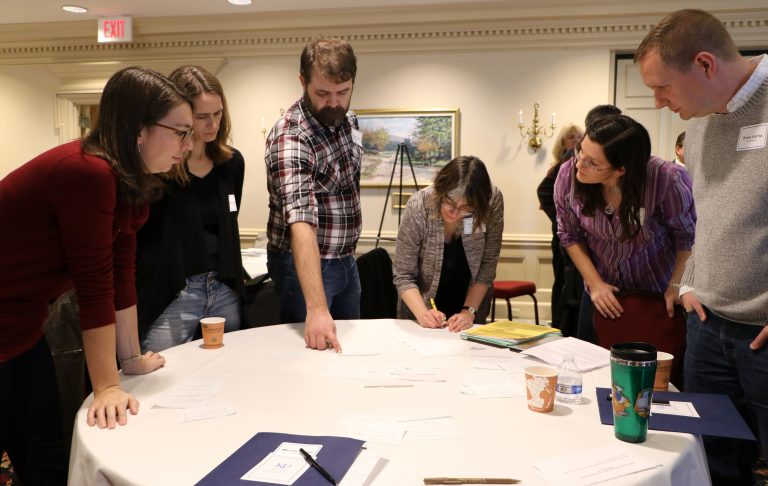
KU’s leadership in student-centered education will be on display at home this week as instructors and administrators from a dozen research universities and educational organizations gather in Lawrence for a three-day institute on teaching and learning. The institute, which begins Thursday, is part of the annual meeting of TRESTLE, a network of faculty and academic leaders who are working with colleagues in their departments to improve teaching in science, technology, engineering and mathematics classes at research universities. TRESTLE is an acronym for transforming education, stimulating teaching and learning excellence.
Attendees will participate in workshops on many facets of course transformation and active learning organized around a theme of sustaining change and broadening participation in student-centered education. Among the speakers are Howard Gobstein, executive vice president of the Association of Public and Land Grant Universities; Pat Hutchings, a senior scholar at the National Institute for Learning Outcomes Assessment; and Mary Huber, a senior scholar at the Bay View Alliance, an international organization working to build leadership for educational change.
“KU has been a hub for transforming teaching and learning for several years,” said Andrea Greenhoot, director of the Center for Teaching Excellence and leader of the TRESTLE network. “TRESTLE has allowed us to expand that community beyond campus and connect with faculty at other universities.”
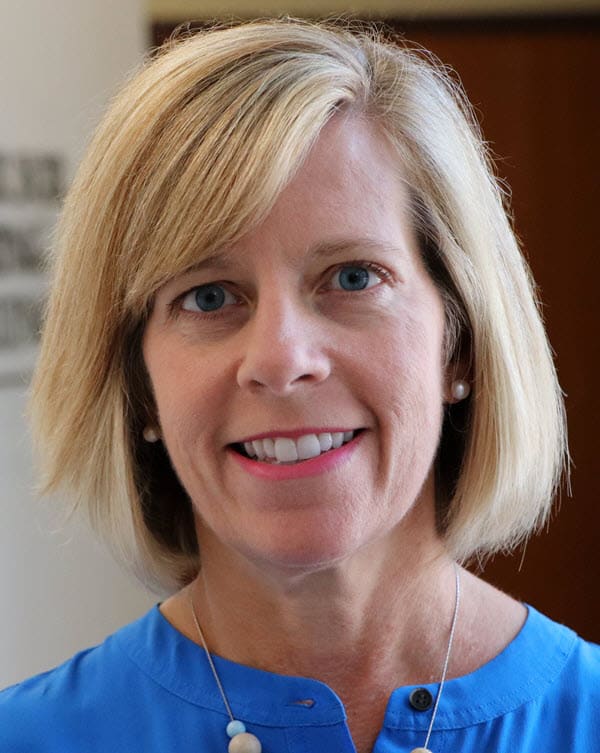
That collaborative approach has been central to the TRESTLE network and to this week’s institute.
“Teaching is often seen as a solitary activity,” Greenhoot said. “It doesn’t have to be that way. Our philosophy at CTE has always been that great teaching requires community. The TRESTLE community provides role models, engages faculty in intellectual discussions about teaching, gives instructors opportunities to reflect on their work, and creates a platform for sharing ideas and results.”
TRESTLE was formed three years ago after Greenhoot, Caroline Bennett, associate professor of engineering, Mark Mort, associate professor of biology, and partners at six other universities received grants totaling $2.5 million from the National Science Foundation. Their work has focused on supporting the development of STEM education experts who work within academic departments. These experts collaborate with other instructors in their departments to incorporate teaching innovations that shift the emphasis away from lecture and engage students in collaborative activities, discussion, problem-solving and projects that lead to better learning. Over the last three years, faculty members involved with TRESTLE have transformed more than 100 courses.
The transformation efforts have been impressive, Greenhoot said, but maintaining the changes after the grant ends in two years will be crucial. Blair Schneider, the program director of TRESTLE, has been coordinating this week’s activities with that in mind.
“We will be asking participants to take on some challenging questions during their time in Lawrence,” Schneider said. “How can we sustain the momentum we’ve built up over the last three years? What will it take to keep departments focused on improving student learning? How do we keep all this going? Everyone involved with TRESTLE has been energized as they have shared ideas and rethought their classes. We want to make sure that energy continues.”
As part of the institute, several KU faculty members are opening their classrooms so that participants can see the results of course transformation. Those instructors are from geology, chemistry, biology, civil engineering, and electrical engineering and computer science. Participants will also have opportunities to see active learning classrooms that KU has created over the past few years.
Open textbook workshop
If you haven’t looked into using open resources in your classes, you should. Open access materials replace costly textbooks, saving students millions of dollars a year even as they provide flexibility for instructors.
Two workshops at KU Libraries in October will help instructors learn how to adopt, adapt and even create open resources for their classes. Josh Bolick, scholarly communication librarian in the Shulenburger Office of Scholarly Communication and Copyright, will the lead the workshops as part of Open Access Week, an international event aimed at increasing awareness of open access materials.
Bolick’s workshops, “Open Textbooks and How They Support Teaching and Learning,” will be held from 9:30 to 11 a.m. on Oct. 19 and Oct. 23 in Watson Library, room 455. You can register here.
Doug Ward is the associate director of the Center for Teaching Excellence and an associate professor of journalism. You can follow him on Twitter @kuediting.
A new approach to introductory physics seems to improve student learning
By Doug Ward
Data analytics holds great potential for helping us understand curricula.
By combining data from our courses (rubrics, grades, in-class surveys) with broader university data (student demographics, data from other courses), we can get a more meaningful picture of who our students are and how they perform as they move through our curricula.
Sarah LeGresley Rush and Chris Fischer in the KU physics department offered a glimpse into what we might learn with a broader pool of university data at a departmental colloquim on Monday. LeGresley Rush and Fischer explained analyses suggesting that a shift in the way an early physics class is structured had led to improvements in student performance in later engineering classes.
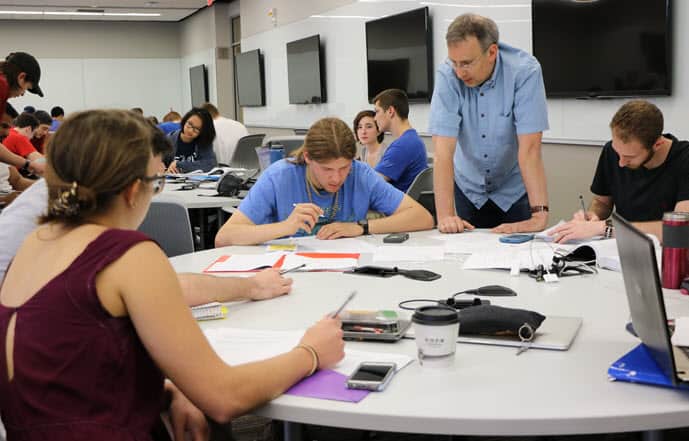
That reference to engineering is correct. Engineering students take introductory physics before many of their engineering classes, and the physics department created a separate class specifically for engineering majors.
A few years ago, Fischer began rethinking the structure of introductory physics because students often struggled with vector mathematics early in the course. In Spring 2015, he introduced what he called an “energy first” approach in Physics 211, focusing on the principle of energy conservation and the use of more applied calculus. The other introductory class, Physics 210, maintained its traditional “force first” curriculum, which explores classical mechanics through the laws of motion and uses little applied calculus. Both classes continued their extensive use of trigonometry and vectors, but Physics 211 adopted considerable material on differentiation and integration, which Physics 210 did not have.
LeGresley Rush, a teaching specialist in physics, joined Fischer, an associate professor, in evaluating the changes in two ways. First, they used results from the Force Concept Inventory, an exam that has been used for three decades to measure students’ understanding of concepts in introductory physics. They also used university analytics to see how students in the two introductory sections fared in a later physics course and in three engineering courses.
In both analyses, students who completed the revised physics courses outperformed students who took the course in the original format. The biggest improvements were among students with ACT math scores below 22. In every grouping of ACT scores they used (22-24, 25-27, 28-30, and above 30), students who took the revised course outperformed those who took the course in the traditional format. Those on the lower end gained the most, though.
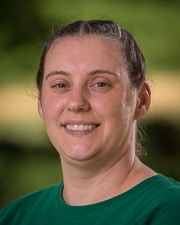
They next looked at how students in the two sections of introductory physics did in the next course in the department sequence, General Physics II. The results were similar, but LeGresley Rush and Fischer were able to compare student grades. In this case, students who completed the transformed course earned grades nearly a point higher in General Physics II than those who took the traditional course.
Finally, LeGresley Rush and Fischer used university data to track student performance in three engineering courses that list introductory physics as a requirement: Mechanical Engineering 211 (Statics and Introduction to Mechanics) and 312 (Basic Engineering Thermodynamics), and Civil Engineering 301 (Statics and Dynamics). Again, students who took the revised course did better in engineering courses, this time by about half a grade point.
“Why?” Fischer said in an earlier interview. “We argue that it’s probably because we changed this curriculum around and by doing so we incorporated more applied mathematics.”
He pointed specifically to moving vector mathematics to later in the semester. Vector math tends to be one of the most difficult subjects for students in the class. By helping students deepen their understanding of easier physics principles first, Fischer said, they are able to draw on those principles later when they work on vectors. There were also some changes in instruction that could have made a difference, he said, but all three physics classes in the study had shifted to an active learning format.
Fischer went to great lengths during the colloquium to point out potential flaws in the data and in the conclusions, especially as skeptical colleagues peppered him with questions. As with any such study, there is the possibility for error.
Nonetheless, Fischer and LeGresley Rush made a compelling case that a revised approach to introductory physics improved student learning in later courses. Perhaps as important, they demonstrated the value of university data in exploring teaching and curricula. Their project will help others at KU tackle similar questions.
The physics project is part of a CTE-led program to use university data to improve teaching, student learning, and retention in science, technology, engineering and math courses. The CTE program, which involves seven departments, is funded by a grant from the Association of American Universities. The Office of Institutional Research and Planning has provided data analysis for the teams.
A helpful tool for finding articles blocked by paywalls
A Chrome browser plug-in called Unpaywall may save a bit of time by pointing you to open access versions of online journal articles ensconced behind paywalls.
The plug-in, which is free, works like this:
When you find a journal article on a subscription-only site, Unpaywall automatically searches for an open version of the article. Often these are versions that authors have posted or that universities have made available through sites like KU Scholar Works. If Unpaywall finds an open copy of the article, it displays a green circle with an open lock on the right side of the screen. You click on the circle and are redirected to the open article.
It’s pretty slick. Unpaywall says its database has 20 million open access articles. It was integrated into Web of Science last year and is now part of many library systems.
Scott Hanrath, associate dean of libraries, said KU Libraries integrated a version of UnPaywall into its system in late 2016. If the “Get at KU” database doesn’t find a match for a source that libraries has access to, it tries the UnPaywall database as an alternative and provides a link if an open version of the article is available.
The Get at KU function is especially helpful in online searches, and the additional database opened even more options for finding articles quickly. I added UnPaywall to my search toolkit, as well. It seems like a useful addition, especially when I’m off campus.
You can read more about Unpaywall in a recent issue of Nature.
Doug Ward is the associate director of the Center for Teaching Excellence and an associate professor of journalism. You can follow him on Twitter @kuediting.
Motivation, mental health and advice for a new academic year
By Doug Ward
The beginning of an academic year is a time of renewal. Our courses and our students start fresh, and we have an opportunity to try new approaches and new course material.
The beginning of an academic year is also a time for sharing advice, information, experiences, and insights. Here are some interesting tidbits I think are worth sharing.
Motivating students (part 1)
Aligning course goals with student goals is an important element of motivating students, David Gooblar, a lecturer in rhetoric at the University of Iowa, writes in The Chronicle of Higher Education.
Many students say they are motivated by grades – actually, many seem obsessed with grades – but that type of motivation doesn’t benefit them intellectually in the long term.
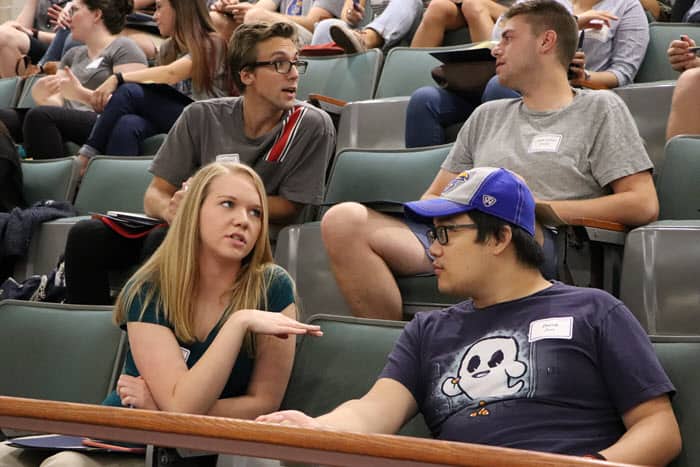
To help stimulate intrinsic motivation, Gooblar uses a low-stakes writing assignment in which students explain their goals for the course and how they hope the course will benefit them in the long term. Gooblar draws on those goals to adapt his class during the semester. Flexibility is important, he says, because it helps show students that he is willing to respond to their needs. That can be a powerful motivator.
I have also had success with having students write about their goals. I frame that in terms of learning goals, explaining to students that I have goals for the class but that I want them to pursue individual goals, too.
Most students struggle with writing individual learning goals because they have never had to think about learning as something they have control over. That thought makes them uncomfortable. They generally see school as a place where someone tells them what to do. I have found that waiting until the second or third week of class makes the process go more smoothly. By then, students have a good sense of what the class is about and they generally offer more thoughtful goals than they might in the first week.
Returning to those goals later in the class is important. I have students reflect on their learning goals at midterm, revising them if they wish, and again at the end of the class. That helps students assess what they have gained intellectually and what they still need to work on. It gives them a sense of accomplishment and helps them gain confidence in self-guided learning. It also gives me additional assessment information, as I ask students to explain which elements of the class helped them learn the most and which didn’t work as well.
Motivating students (part 2)
Shannon Portillo, associate professor of public affairs and administration, offers additional advice for motivating students.
Writing in Inside Higher Ed, Portillo, who is also the assistant vice chancellor for undergraduate programs at the Edwards Campus, has students help set guidelines for class engagement, using the exercise to help them feel invested in the class from the start.
At the end of the class, she asks students to evaluate their participation. They give her a suggested grade on their participation and provide evidence to back it up. She doesn’t always agree with their assessment, and ultimately determines the grade herself. Men tend to give themselves high marks, she says, while women tend to be more critical of themselves. The evaluation process helps students reflect on their contributions to the class and on their own learning.
Motivation (part 3). Faculty Focus offers additional tips on motivating students, including offering good feedback; helping students understand how learning works; providing engaging course materials and activities and explaining their relevance; and making greater use of cooperative and collaborative work.
Technology can help, but …
In a survey by Campus Technology, 73 percent of faculty members said that technology had made their jobs easier and 87 percent said it had improved their ability to teach. On the other hand, 19 percent said technology had made their job harder or much harder.
The survey did not say how technology had made things more difficult, but a comment on the article blamed it on a lack of training that ties pedagogy to the use of technology. That makes sense, but sometimes instructors fail to take advantage of the many available resources. KU has many resources for learning technology, including desk-side coaching and frequent workshops.
Student writing: No help needed?
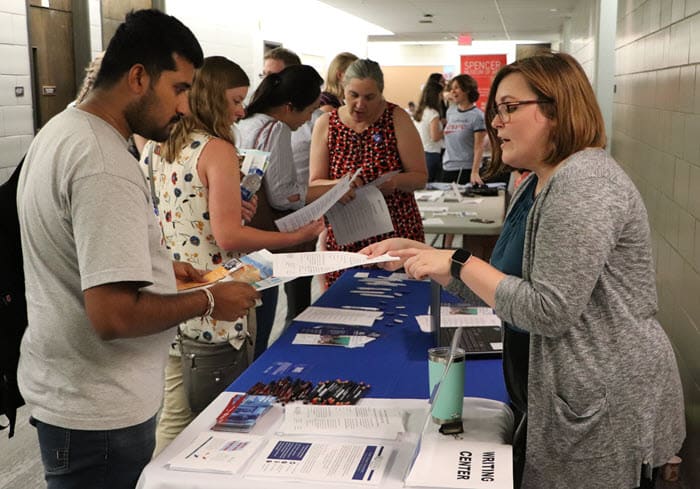
In a recent survey by the Primary Research Group, only 8 percent of freshmen and sophomores said they thought they needed help with grammar and spelling. Yes, 8 percent.
Just as troubling, 46 percent of all students said they needed no additional writing instruction in their college classes.
Apparently, those 46 percent haven’t read any of the papers they have turned in or the email messages they have sent.
My intent isn’t to bash college students. Rather, it’s to remind instructor that as we help students, we sometimes need to remind them that they need our help and that resources like the KU Writing Center can provide crucial assistance.
The survey was reported by Inside Higher Ed.
Mental health and students
A growing percentage of students say they suffer from depression, anxiety and other mental health issues. That holds true for both undergraduates and graduate students.
At KU, for instance, Counseling and Psychological Services reported year-over-year increases in visits of 1 percent (November) to 73 percent (May) in the 2017-18 academic year.
One of the most important things faculty members can do is to pay attention to students and help them find the resources they need. Make sure that students know about Counseling and Psychological Services. I’ve made several calls to CAPS over the years, helping students schedule appointments with counselors. CAPS has other resources like drop-in hours with peer educators and group therapy sessions.
The Office of Student Affairs is another important resource. Its website provides an extensive list of advice and services for students and faculty members.
The Conversation noted recently that two of the biggest challenges to helping students with psychological issues are reluctance to talk about mental health and a reluctance to reach out for help. Instructors can help break down that stigma by being empathetic and accessible. They shouldn’t try to be psychological counselors. That’s not their role. They can listen to students, though, offer empathy and support, and help them take that first step toward getting help.
A final thought
A quote from Ryan Craig, managing director of University Ventures and author of A New U: Faster + Cheaper Alternatives to College, helps put issues of student mental health, attitude and motivation into context. In an interview with EdSurge, he said:
“We have developed this cult that you’re either going to go to college or if you don’t, maybe you’ll end up on Skid Row. I’m being a little facetious—but not that facetious. It literally has evolved to that point. A bachelor’s degree is the ticket to success and not having a bachelor’s degree is opposite.”
Doug Ward is the associate director of the Center for Teaching Excellence and an associate professor of journalism. You can follow him on Twitter @kuediting.
New CTE program helps spur curriculum innovation
By Doug Ward
Putting innovative curricular ideas into practice takes time and coordination among instructors, especially when several classes are involved.
To help jump-start that process, CTE has created a Curriculum Innovation Program and selected four teams of faculty members who will transform important components of their curricula over the coming year.
Each of the four teams will receive $10,000 to $12,000 for the project, along with up to $5,000 for team members to visit an institution that has had success in innovating its curriculum. The awards, the largest that CTE has ever made, were made possible by a donation from Bob and Kathie Taylor, KU alumni from Wichita.

The four teams were chosen from among 18 submissions from across the university. The winners, from environmental studies, geology, journalism and mass communications, and linguistics, were recognized at KU’s annual Teaching Summit on Thursday.
“We really wanted to see ideas that would have a big impact on student learning in a short amount of time,” said Andrea Greenhoot, director of the Center for Teaching Excellence. “We also wanted the changes to be sustainable. The four programs selected made the strongest cases for that.”
To help with the curricular changes, the teams will meet with each other and CTE faculty leaders throughout the academic year to discuss their progress and challenges. The goal of the program is to nurture changes that improve learning and retention, and provide new ways of preparing students for an ever-changing career landscape. Each team will concentrate on remaking two or more courses within a curriculum.
The winning teams all take different approaches to the innovation challenge. Here are their plans:
Environmental studies
The environmental studies program has undergone considerable change over the past eight years as core faculty members have left and the number of students taking classes in the program has tripled. The program, which draws from such fields as ecology, law, English, geology, and social sciences, will build on the diverse perspectives of its faculty members by creating modules that focus on interdisciplinary problem-solving. The modules will allow instructors to bring multiple perspectives to two 100-level classes, Global Environmental Change I and II, and make it easier for additional instructors to teach those courses. At the capstone level, the modules will allow students to go into more depth in such areas as informatics, systems thinking, technical communication, and project management, while maintaining an emphasis on work that benefits communities. Team members are Ali Brox, David Fowle, Kelly Kindscher, Terry Loecke, Peggy Schultz, and Paul Stock.
Geology
The department has transformed five introductory courses since 2013 by integrating such practices as group problem-solving, two-stage exams, and an end-of-semester event to showcase student work. Those and other approaches have improved learning for all students but have been especially effective for women and underrepresented minority students. For example, women used to fail or withdraw from Geology 101 at a much higher rate than men. Those disparities have been eliminated over the past few years as the class has shifted from lecture to active learning. The department plans to apply those techniques to two upper-level courses that prepare students for a capstone course. It will shift some material for those courses online, reduce the amount of in-class lecturing, add writing and data-synthesis assignments, and reorganize course components so that students learn in incremental ways, an approach known as scaffolding. Team members are Diane Kamola, Andreas Moeller, Noah McLean, and Alison Olcott.
Journalism and mass communications
The many fields of journalism have undergone enormous changes over the past two decades as digital communication has upended the media landscape. Four instructors in the School of Journalism’s strategic communication track plan to help students better keep up with those changes by creating a data hub for social media, shifting more elements of learning online, and providing more opportunities for experiential learning. Strategic communication, which accounts for more than two-thirds of the school’s enrollment, prepares students for careers in such areas as public relations, marketing, and advertising. The journalism team will concentrate on four courses at the 400- and 600-levels, including a capstone course, better integrating elements of social media into the curriculum. Creation of a social media hub will allow students to gain more hands-on experiences with social media, and the work students do with the hub will create additional resources for future students and courses. Faculty members involved are Hyejin Bang, Yvonnes Chen, Joseph Erba, and Hyunjin Seo.
Linguistics
The Department of Linguistics has been a university leader in evaluating student learning and in making curricular adjustments based on learning data it gathers. The department plans to build on that work by modifying, expanding and restructuring three courses that have proved especially challenging for students. Instructors plan to add interactive assignments and group case studies to Introductory Linguistics to help students learn theoretical concepts of language structure. They also plan to create an online version of that course so that it can be offered more often. For a mid-level course in syntax, instructors will create online materials for students to work through on their own, freeing up class time for group problem-solving and application. For an upper-level course in neurolinguistics, the department plans to add lab work that will give students practice in such areas as experimental design and data analysis for brain imaging. Faculty members involved in the project are Kate Coughlin, Phil Duncan, Robert Fiorentino, Alison Gabriele, John Gluckman, Andrew McKenzie, Joan Sereno, Anie Tremblay, and Jie Zhang.

Doug Ward is the associate director of the Center for Teaching Excellence and an associate professor of journalism. You can follow him on Twitter @kuediting.
The importance of humanity in education’s future
By Doug Ward
Robin Wright has a clear vision of the future of education.
Understanding that future requires a look 6,000 years into the past, though. It requires an assessment of the technological wonders that have promised revolution over the years. It requires an understanding of literacy rates, which have reached 90 percent worldwide. It requires a look into the chemistry of the brain, which reacts to emotion and stress but also to action and interaction. It requires a look outward at the students in our classes. And perhaps most important, it requires a look inward at who we are and who we aspire to be.

Wright made it clear that if we can do that, we, too, will have a clear vision of education’s future. (More about that shortly.)
Wright, a professor of biological sciences at the University of Minnesota, was the keynote speaker at KU’s annual Teaching Summit on Thursday. She shared with the summit’s 400 participants some of her research into active learning and student development, along with personal experiences in teaching undergraduate biology courses. Some of those experiences involved her own challenges as a teacher, including times when students simply weren’t understanding what she was teaching.
“This is where I made a big mistake,” Wright said. “If my students weren’t performing well, I just worked harder. That wasn’t a problem for them; they weren’t working harder. I wasn’t putting the burden on them.”
That is, she wasn’t following the key principles of learning. Here’s how she described those:
- Every brain is different.
- The person who does the work does the learning.
- You can only make memories by connecting them to older memories.
- People almost always learn better when they work together.
- Making memories requires repetition, feedback, elaboration and sleep.
Until students do the hard work that learning requires, it doesn’t matter how many times instructors go over course material or how much effort they put into making classes active and engaging, Wright said. Mastery requires time and effort.
Don’t get the wrong idea from that. What instructors do has an enormous impact. Teaching and learning require concerted efforts by both students and instructors. That effort works best with human interaction, though. That was the message that Wright delivered again and again: that in a technology-fueled world, the human elements of education are more important than ever.
“The most important way we can be human is to teach,” Wright said.
Wright’s keynote address and workshops she led later in the morning tied into the summit’s theme, Teaching the Whole Student. That theme evolved from recent research suggesting that a holistic approach to education helps students succeed. We can’t just teach content. Nor can we throw students into that content and expect them to learn on their own. Rather, instructors and universities must engage students in education and help them gain a sense of belonging; support them in their educational endeavors and help them overcome barriers; and provide mentoring from staff members, faculty members and students’ peers.

After the summit, Wright said that her message would not have been well received just a few years ago. Even now, critics berate universities for coddling students and encouraging hypersensitivity rather than pushing them to harden themselves for an unforgiving world. Wright steered clear of the political hyperbole, grounding her arguments in science, history, and the scholarship of teaching and learning. Even so, she acknowledged her role as provocateur as she made a case for what education is and what it could be.
Naysayers have tried to displace in-person education for centuries, she said. The first known correspondence course – one for shorthand – was offered in 1728. In 1906, a correspondence degree program in Pennsylvania attracted a million people but had a graduation rate of 2.6 percent, about the same as today’s massive open online courses. Thomas Edison promoted the phonograph as a great educational tool. Broadcasters did the same with radio and then television. MOOC creators promised a revolution – one that fizzled before it barely started.
Despite all these other opportunities and all the new technological tools that have emerged, we still have in-person education. Furthermore, Wright said, 90 percent of the world’s population can read and write. More and more of that population has access to the Internet and its vast universe of information, meaning that people can learn just about anything and anywhere on their own. And yet year after year, students and instructors still gather in classrooms to learn.
Why? she asked, quickly providing her own answer: Because the way we learn hasn’t changed since the days when people gathered around campfires, shared stories, and helped each other understand the world.
“Our brains are still the same as they were 6,000 years ago,” Wright said. “We still learn in the same way, the same basic way. That has not changed at all.”
Teaching to hundreds of brains
Wright explained the importance of brain chemistry and the role that stress, emotion, and sleep play in our ability to learn. She touched on social theory as a means of explaining learning, and the way that such factors as pedagogy, classroom climate, focus, motivation and metacognition influence individual performance. Our growing understanding of those factors continues to improve teaching.
“The challenge, though,” she said, “is how do you teach a whole class about mitosis when you have 400 different brains you have to interact with?”
That is, the same strategy doesn’t work for everyone.
“People look at things in different ways because their brains are different,” Wright said.
That’s where the human aspects of teaching must take over.
“We have to consider the whole person as a living, breathing, complicated, annoying, wonderful human being,” Wright said.
To emphasize that, Wright told of a high school teacher who once told her she was a good writer. Decades later, Wright still remembers that praise fondly, and she urged attendees to make the most of human interaction with their students.
“If you can do one thing to improve the effectiveness of your teaching and your learning, it’s to give people a chance to interact,” Wright said.
Adding a human touch to education also helps shape the future, she said.
“Being able to put your arm around a student and say, ‘You are really, really good at biology. I think you could have a career in it.’ That has enormous, enormous impact,” Wright said.
That doesn’t mean we should shy away from technology. Not at all. We should use it to its full potential to personalize teaching and learning, she said. In the end, though, the future of education lies in its humanity.
“There’s power in you as a living human being interacting with other human beings,” Wright said.
That power has kept education alive for millennia. And if Wright’s vision is correct, it will propel higher education into the future.
Doug Ward is the associate director of the Center for Teaching Excellence and an associate professor of journalism. You can follow him on Twitter @kuediting.
Study links rising tuition to decreased diversity
By Doug Ward
Here’s one more reason to worry about rising tuition rates: decreased diversity.
In an examination of 14 years of tuition increases at public colleges and universities, Drew Allen of Princeton University and Gregory Wolniak of New York University found that for every $1,000 that tuition goes up, racial and ethnic diversity among students goes down by 4.5 percent.
To put that into perspective, they point to a College Board report showing that between 2008 and 2018, average tuition and fees at public four-year colleges and universities increased $2,690, or 37 percent. In some cases, tuition rose by $1,000 in only a year or two, they write in The Conversation.

Allen and Wolniak’s study examined 600 four-year and 1,000 two-year public institutions between 1998 and 2012. The correlation between increases in tuition and declines in diversity was most pronounced at colleges and universities they described as the “least-selective.”
Relatedly, they found that a 1 percent increase in tuition at four-year private colleges or universities led to a 3 percent increase in diversity at nearby public institutions. In other words, tuition increases make a difference at both public and private universities.
“The end result is the nation’s colleges and universities become less reflective of the ethnic diversity of the United States as a whole,” Allen and Wolniak write.
The highest rejection rates, state by state
In the status-obsessed universe of higher education, colleges and universities often measure their standing by the percentage of students they reject.
It’s a circular process. Institutions deemed to be the best receive the highest numbers of applications. Those with the highest number of applications reject larger numbers of students, solidifying their desirability by maintaining low acceptance rates.
I won’t get into the validity of that game here, but I did think a recent a recent state-by-state list of colleges and universities with the lowest acceptance rates was interesting. You can guess many of them: Harvard (5.4 percent acceptance rate), Yale (6.3 percent), Princeton (6.5 percent), University of Chicago (7.9 percent).
You’ll probably have a harder time determining which universities in states other than Massachusetts, Connecticut, New Jersey, and Illinois have the lowest acceptance rates. At least I did. The website 24/7 Wall Street listed those universities in an article called “The Hardest Colleges to Get Into in Every State.” Not surprisingly, most are private universities, although a fair number are public.
In Kansas, Sterling College has the lowest acceptance rate (37.4 percent). That compares with more than 90 percent at KU, K-State and Wichita State. Other regents universities have slightly lower admission rates.
For comparison, here are the universities in surrounding states with the lowest admission rates:
- Colorado: Air Force Academy (15.1 percent)
- Iowa: Grinnell College (20.2 percent)
- Missouri: Washington University (16.5 percent)
- Nebraska: Creighton University (70.7 percent)
- Oklahoma: University of Tulsa (37 percent)
These are the state universities that made the list:
- University of Alaska (73.5 percent)
- University of Arkansas (41.9 percent)
- Clemson (50.5 percent)
- Delaware State University (40.6 percent)
- Georgia Tech (25.8 percent)
- University of Idaho (75.9 percent)
- University of Michigan-Ann Arbor (28.6 percent)
- University of Washington-Seattle (45.3 percent)
- University of Wisconsin-Madison (52.6 percent)
- University of Wyoming (95.1 percent)
Interestingly, the increasing difficulty of getting into some public universities was recently identified as one of the top education trends to watch during the coming academic year. Scott Jaschik, editor of Inside Higher Ed, listed the growth of “public Ivies” among a trends list he offered to members of the Education Writers Association. In addition, he said, some universities have increased the number of students they put on waitlists, raising students’ hopes even as the likelihood of eventual admission declines.
Briefly …
A new study in the interdisciplinary journal PLOS One offers additional evidence for providing pedagogical training to graduate students. The study found that Ph.D. students who were trained in evidence-based teaching practices were just as good at research as those who focused on research alone. … MindShift offers four useful principles for approaching student-centered learning. The article is aimed at K-12 instructors, but it applies to college instructors, as well. … More colleges and universities now use Canvas than use Blackboard, e-Literate reports. In terms of market share, the two are tied at 28 percent, but Canvas has two more institutional users than Blackboard.
Doug Ward is the associate director of the Center for Teaching Excellence and an associate professor of journalism. You can follow him on Twitter @kuediting.